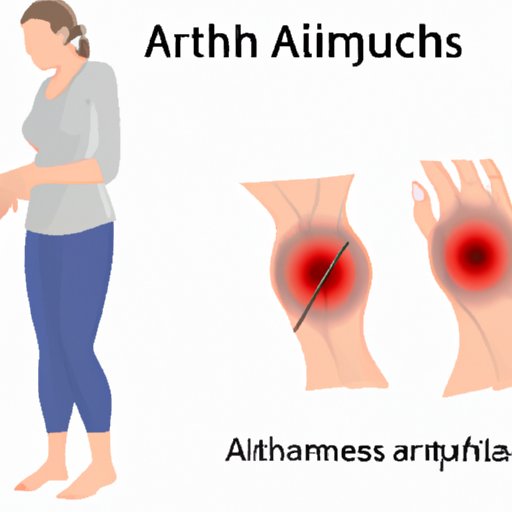
I. Introduction
Rheumatoid Arthritis (RA) is an autoimmune condition that mainly affects joints but can also impact other areas of the body. It is important to know the symptoms of RA so that it can be diagnosed and treated early. Early diagnosis and treatment can help prevent further joint damage and improve overall quality of life.
II. 10 Common Symptoms of Rheumatoid Arthritis You Should Know About
The ten most common symptoms of RA are joint pain, joint stiffness, swelling, fatigue, fever, loss of appetite, muscle pain, weakness, redness and warmth around the joint, and morning stiffness lasting over an hour. Joint pain is often the first and most noticeable symptom of RA. It can be felt in different parts of the body, including hands, feet, wrists, elbows, and knees.
III. How to Identify Rheumatoid Arthritis: A Comprehensive List of Symptoms
In addition to the ten common symptoms listed above, RA can cause other symptoms such as joint deformity, nodules, and eye inflammation. Joint deformity can occur over time as the disease progresses, leading to irreversible damage. Nodules are small lumps that can be felt under the skin and are usually non-painful. Eye inflammation can cause dryness, redness and pain.
IV. 7 Warning Signs of Rheumatoid Arthritis You Shouldn’t Ignore
If you experience continuous joint pain, swelling, stiffness, limited joint movement, fever, fatigue, and weight loss, it is important to see a doctor. These seven warning signs may indicate a more severe form of RA, which requires more immediate treatment. Treatment options include medication, physical therapy, and surgery.
V. Living with Rheumatoid Arthritis: Understanding the Symptoms
RA symptoms can make everyday activities more challenging, but there are ways to manage them and improve quality of life. For example, exercise can help strengthen muscles and improve joint flexibility. A balanced diet can support overall health and reduce inflammation. Stress management techniques like meditation, deep breathing, and yoga can also be helpful.
VI. From Stiff Joints to Fatigue: The Top Symptoms of Rheumatoid Arthritis
Stiff joints and fatigue are two of the most common symptoms of RA. Stiffness is often worse in the morning and can last several hours. Fatigue can be debilitating and make it hard to carry out regular activities. Other symptoms of RA include weakness, loss of appetite and weight, and dry eyes and mouth. Everyone experiences RA differently, and some may have more severe symptoms than others.
VII. When to Suspect Rheumatoid Arthritis: Understanding the Early Symptoms
Early symptoms of RA include joint pain, fatigue, stiffness, and tenderness. These symptoms can come and go, and it can be easy to attribute them to other causes. But if you experience them for an extended period of time, it may be important to see a doctor. Early treatment for RA can help slow or prevent joint damage and improve overall outcomes.
VIII. From Swollen Joints to Flu-Like Symptoms: Exploring the Many Signs of Rheumatoid Arthritis
Swelling is a common symptom of RA and occurs when the tissue surrounding a joint becomes inflamed. Along with joint pain, this can lead to joint stiffness and difficulty moving. RA can also cause flu-like symptoms such as fever, chills, and headaches, and can lead to a general feeling of unwellness. It’s important to note that not everyone with RA experiences the same symptoms, and it can be challenging to diagnose.
IX. Conclusion
RA symptoms can be painful and disruptive, but early diagnosis and treatment can help manage them. It’s important to see a doctor if you’re experiencing any of the symptoms listed above for an extended period of time. With a comprehensive treatment plan, including medication, exercise, and stress management techniques, those living with RA can experience an improved quality of life.
If you have been experiencing RA symptoms, seek medical attention immediately. For additional resources and information on managing RA symptoms, visit the Rheumatoid Arthritis Foundation or speak with your healthcare provider.





